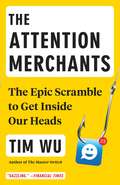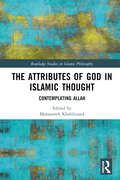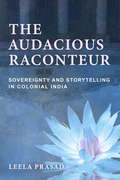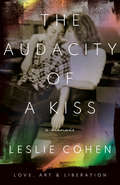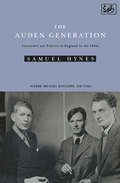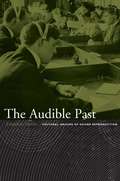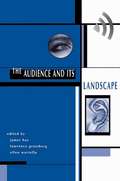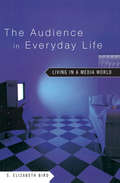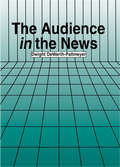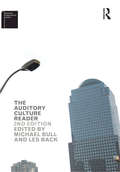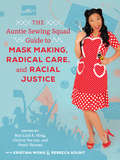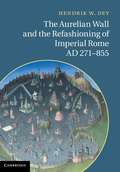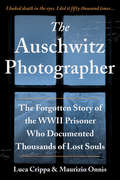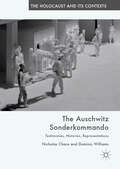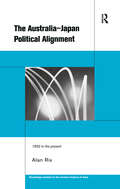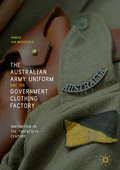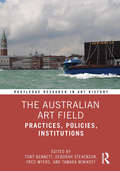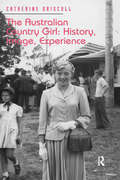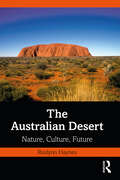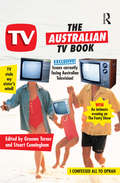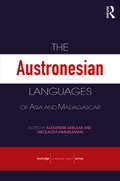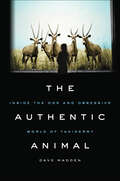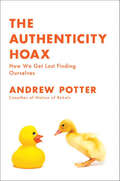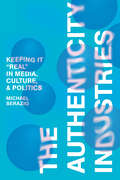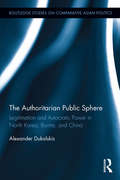- Table View
- List View
The Attention Merchants: The Epic Scramble to Get Inside Our Heads
by Tim WuFrom Tim Wu, author of the award-winning The Master Switch and who coined the phrase "net neutrality"--a revelatory look at the rise of "attention harvesting," and its transformative effect on our society and our selves. Attention merchant: an industrial-scale harvester of human attention. A firm whose business model is the mass capture of attention for resale to advertisers.In nearly every moment of our waking lives, we face a barrage of advertising enticements, branding efforts, sponsored social media, commercials and other efforts to harvest our attention. Over the last century, few times or spaces have remained uncultivated by the "attention merchants," contributing to the distracted, unfocused tenor of our times. Tim Wu argues that this is not simply the byproduct of recent inventions but the end result of more than a century's growth and expansion in the industries that feed on human attention. From the pre-Madison Avenue birth of advertising to TV's golden age to our present age of radically individualized choices, the business model of "attention merchants" has always been the same. He describes the revolts that have risen against these relentless attempts to influence our consumption, from the remote control to FDA regulations to Apple's ad-blocking OS. But he makes clear that attention merchants grow ever-new heads, and their means of harvesting our attention have given rise to the defining industries of our time, changing our nature--cognitive, social, and otherwise--in ways unimaginable even a generation ago.From the Hardcover edition.
The Attributes of God in Islamic Thought: Contemplating Allah (Routledge Studies in Islamic Philosophy)
by Mansooreh KhalilizandThe debate over Allah’s attribute—the “nature” and the inner articulation of Allah—is one of the focal debates in the intellectual history of Islam. This edited collection aims to highlight and examine some aspects of this debate in their original context, based on the relevant primary literature.By showing that even an apparently self-evident concept such as Allah, which lies at the heart of every reading of Islam, is highly ambiguous and polysemous, the chapters also emphasise the plurality that has always existed in Islamic thought. Through highlighting the philosophical and theological reflections on the concept of Allah, the results of this study challenge the juristic reading of Islam, in which Allah’s function consists mainly in providing a detailed plan for the human life and also rewarding or punishing the ones who deviates from it. The book also attempts to demonstrate the relevance and the actuality of the tradition and to stress its contemporaneity.This volume makes a significant part of the intellectual tradition of Islam accessible for students and scholars of Islamic theology, Islamic philosophy, Islamic studies and the like, as well as providing a secondary source for teaching on the debate in question.
The Audacious Raconteur: Sovereignty and Storytelling in Colonial India
by Leela PrasadCan a subject be sovereign in a hegemony? Can creativity be reined in by forces of empire? Studying closely the oral narrations and writings of four Indian authors in colonial India, The Audacious Raconteur argues that even the most hegemonic circumstances cannot suppress "audacious raconteurs": skilled storytellers who fashion narrative spaces that allow themselves to remain sovereign and beyond subjugation. By drawing attention to the vigorous orality, maverick use of photography, literary ventriloquism, and bilingualism in the narratives of these raconteurs, Leela Prasad shows how the ideological bulwark of colonialism—formed by concepts of colonial modernity, history, science, and native knowledge—is dismantled. Audacious raconteurs wrest back meanings of religion, culture, and history that are closer to their lived understandings. The figure of the audacious raconteur does not only hover in an archive but suffuses everyday life. Underlying these ideas, Prasad's personal interactions with the narrators' descendants give weight to her innovative argument that the audacious raconteur is a necessary ethical and artistic figure in human experience.
The Audacity of a Kiss: Love, Art, and Liberation
by Leslie CohenRendered in bronze, covered in white lacquer, two women sit together on a park bench in Greenwich Village. One of the women touches the thigh of her partner as they gaze into each other’s eyes. The two women are part of George Segal’s iconic sculpture “Gay Liberation,” but these powerful symbols were modeled on real people: Leslie Cohen and her partner (now wife) Beth Suskin. In this evocative memoir, Cohen tells the story of a love that has lasted for over fifty years. Transporting the reader to the pivotal time when brave gay women and men carved out spaces where they could live and love freely, she recounts both her personal struggles and the accomplishments she achieved as part of New York’s gay and feminist communities. Foremost among these was her 1976 cofounding of the groundbreaking women’s nightclub Sahara, which played host to such luminaries as Betty Friedan, Gloria Steinem, Pat Benatar, Ntozake Shange, Rita Mae Brown, Adrienne Rich, Patti Smith, Bella Abzug, and Jane Fonda. The Audacity of a Kiss is a moving and inspiring tale of how love, art, and solidarity can overcome oppression.
The Auden Generation
by Samuel HynesThis is a study of a literary generation writing in a period of expanding fears and ever more urgent political and social crises. The pace of the time itself, the sense of time passing and an end approaching gave a special quality to the Thirties. The public world pressed insistently on the private world. For those who came of literary age - Auden, Day Lewis, MacNeice, Spender, Graham Greene, Isherwood and Orwell among them - writing became a form of action. In the process a generation discovered itself and found its own expression.
The Audible Past: Cultural Origins of Sound Reproduction
by Jonathan SterneThe Audible Past explores the cultural origins of sound reproduction. It describes a distinctive sound culture that gave birth to the sound recording and the transmission devices so ubiquitous in modern life. With an ear for the unexpected, scholar and musician Jonathan Sterne uses the technological and cultural precursors of telephony, phonography, and radio as an entry point into a history of sound in its own right. Sterne studies the constantly shifting boundary between phenomena organized as "sound" and "not sound. " In The Audible Past, this history crisscrosses the liminal regions between bodies and machines, originals and copies, nature and culture, and life and death. Blending cultural studies and the history of communication technology, Sterne follows modern sound technologies back through a historical labyrinth. Along the way, he encounters capitalists and inventors, musicians and philosophers, embalmers and grave robbers, doctors and patients, deaf children and their teachers, professionals and hobbyists, folklorists and tribal singers. The Audible Past tracks the connections between the history of sound and the defining features of modernity: from developments in medicine, physics, and philosophy to the tumultuous shifts of industrial capitalism, colonialism, urbanization, modern technology, and the rise of a new middle class. A provocative history of sound, The Audible Past challenges theoretical commonplaces such as the philosophical privilege of the speaking subject, the visual bias in theories of modernity, and static descriptions of nature. It will interest those in cultural studies, media and communication studies, the new musicology, and the history of technology.
The Audience and Its Landscape (Cultural Studies)
by James HayThis book offers a major reconceptualization of the term “audience,” including the landscape of a given audience—the situated and territorializing features of any way of seeing and defining the world. Given de Certeau's hypothesis that listening, watching, and reading all occur in places and result in produce transformed paths or spaces, the contributors to this landmark volume have provided innovative essays analyzing the transformations that take place in the geography between sender and receiver. The book acknowledges, in the face of conventional “discourse analysis,” the contextual features of discourse, to produce a complex and textured understanding of the concept of audience.The Audience and Its Landscape, presents the work of a vital cross-section of international scholars including Sweden's Karl Erik Rosengren, the UK's Jay G. Blumler and Roger Silverstone, Australia's Tony Bennett, Israel's Elihu Katz, Canada's Martin Allor, and the United States's Janice Radway, Byron Reeves, and John Fisk, to name a few. This book is truly groundbreaking in its depth and scope, and will speak to students of rhetoric, mass communication, cultural studies, anthropology, and sociology alike.
The Audience in Everyday Life: Living in a Media World
by S. Elizabeth BirdThe Audience in Everyday Life argues that a media audience cannot be studied in front of the television alone--their interaction with media does not simply end when the set is turned off. Instead, we must study the daily lives of audiences to find the undercurrents of media influence in everyday life. Bird provides a host of useful tools and methods for scholars and students interested in the ways media is consumed in everyday life.
The Audience in the News (Routledge Communication Series)
by Dwight DeWerth-PallmeyerIn recent years, communication scholars have taken a renewed interest in analyzing the audience and its impact on the communication process. Similarly, news editors and producers have often turned toward a marketing orientation which seeks to give new readers and viewers what they want, or at least what they say they want. Yet, there has still been little written about just how the audience factors into the news which is produced. Seeking to fill that niche, this book argues that audience images are quite important in the construction of news, but not easily detected. That is because journalists are not principally interested in their audience; they are interested in the news. USE THIS PARAGRAPH ONLY FOR GENERAL CATALOGS... This volume argues that although journalistic images of the audience may be "incomplete," they do exist and powerfully help shape the work of journalists in producing journalistic texts. Using a case study of news workers and news texts at two Chicago newsgathering organizations, the Chicago Tribune and WGN-TV, this book: * examines notions of audience and how they have been treated by academicians, * presents a detailed description of the ways in which audience is embedded within the news construction process, * presents a very representative set of journalistic news values, * presents differing ideas of audience at three key levels of the news organizations -- reporters and news gatherers, editors and producers, and senior editors, producers, and news directors, and * seeks to summarize and position this study within the larger body of mass communication research.
The Auditory Culture Reader (Sensory Formations)
by Michael BullThe first edition of The Auditory Culture Reader offered an introduction to both classical and recent work on auditory culture, laying the foundations for new academic research in sound studies. Today, interest and research on sound thrives across disciplines such as music, anthropology, geography, sociology and cultural studies as well as within the new interdisciplinary sphere of sound studies itself. This second edition reflects on the changes to the field since the first edition and offers a vast amount of new content, a user-friendly organization which highlights key themes and concepts, and a methodologies section which addresses practical questions for students setting out on auditory explorations. All essays are accessible to non-experts and encompass scholarship from leading figures in the field, discussing issues relating to sound and listening from the broadest set of interdisciplinary perspectives. Inspiring students and researchers attentive to sound in their work, newly-commissioned and classical excerpts bring urban research and ethnography alive with sensory case studies that open up a world beyond the visual. This book is core reading for all courses that cover the role of sound in culture, within sound studies, anthropology, sociology, cultural studies, history, media studies and urban geography.
The Auntie Sewing Squad Guide to Mask Making, Radical Care, and Racial Justice
by Mai-Linh K. Hong, Chrissy Yee Lau, and Preeti SharmaThe rise of the Auntie Sewing Squad, a massive mutual-aid network of volunteers who provide free masks in the wake of US government failures during the COVID-19 pandemic. In March 2020, when the US government failed to provide personal protective gear during the COVID-19 pandemic, the Auntie Sewing Squad emerged. Founded by performance artist Kristina Wong, the mutual-aid group sewed face masks with a bold social justice mission: to protect the most vulnerable and most neglected. Written and edited by Aunties themselves, The Auntie Sewing Squad Guide to Mask Making, Radical Care, and Racial Justice tells a powerful story. As the pandemic unfolded, hate crimes against Asian Americans spiked. In this climate of fear and despair, a team of mostly Asian American women using the familial label "Auntie" formed online, gathered momentum, and sewed masks at home by the thousands. The Aunties nimbly made and funneled masks to asylum seekers, Indigenous communities, incarcerated people, farmworkers, and others disproportionately impacted by COVID-19. When anti-lockdown agitators descended on state capitals—and, eventually, the US Capitol—the Aunties dug in. And as the nation erupted in rebellion over police violence against Black people, the Aunties supported and supplied Black Lives Matter protesters and organizations serving Black communities. Providing hundreds of thousands of homemade masks met an urgent public health need and expressed solidarity, care, and political action in a moment of social upheaval. The Auntie Sewing Squad is a quirky, fast-moving, and adaptive mutual-aid group that showed up to meet a critical need. Led primarily by women of color, the group includes some who learned to sew from mothers and grandmothers working for sweatshops or as a survival skill passed down by refugee relatives. The Auntie Sewing Squad speaks back to the history of exploited immigrant labor as it enacts an intersectional commitment to public health for all. This collection of essays and ephemera is a community document of the labor and care of the Auntie Sewing Squad.
The Aurelian Wall and the Refashioning of Imperial Rome, AD 271–855
by Hendrik W. DeyThis book explores the relationship between the city of Rome and the Aurelian Wall during the six centuries following its construction in the 270s AD, a period when the city changed and contracted almost beyond recognition, as it evolved from imperial capital into the spiritual center of Western Christendom. The Wall became the single most prominent feature in the urban landscape, a dominating presence which came bodily to incarnate the political, legal, administrative and religious boundaries of urbs Roma, even as it reshaped both the physical contours of the city as a whole and the mental geographies of 'Rome' that prevailed at home and throughout the known world. With the passage of time, the circuit took on a life of its own as the embodiment of Rome's past greatness, a cultural and architectural legacy that dwarfed the quotidian realities of the post-imperial city as much as it shaped them.
The Auschwitz Photographer: The Forgotten Story of the WWII Prisoner Who Documented Thousands of Lost Souls
by Luca Crippa Maurizio OnnisThe Nazis asked him to swear allegiance to Hitler, betraying his country, his friends, and everything he believed in.He refused.Poland, 1939. Professional photographer Wilhelm Brasse is deported to Auschwitz-Birkenau and finds himself in a deadly race to survive, assigned to work as the camp's intake photographer and take "identity pictures" of prisoners as they arrive by the trainload. Brasse soon discovers his photography skills are in demand from Nazi guards as well, who ask him to take personal portraits for them to send to their families and girlfriends. Behind the camera, Brasse is safe from the terrible fate that so many of his fellow prisoners meet. But over the course of five years, the horrifying scenes his lens capture, including inhumane medical "experiments" led by Josef Mengele, change Brasse forever.Based on the true story of Wilhelm Brasse, The Auschwitz Photographer is a stark black-and-white reminder of the horrors of the Holocaust. This gripping work of World War II narrative nonfiction takes readers behind the barbed wire fences of the world's most feared concentration camp, bringing Brasse's story to life as he clicks the shutter button thousands of times before ultimately joining the Resistance, defying the Nazis, and defiantly setting down his camera for good.
The Auschwitz Sonderkommando: Testimonies, Histories, Representations (The Holocaust and its Contexts)
by Nicholas Chare Dominic WilliamsThis book is the first to bring together analyses of the full range of post-war testimony given by survivors of the Sonderkommando of Auschwitz-Birkenau. The Auschwitz Sonderkommando were slave labourers in the gas chambers and crematoria, forced to process and dispose of the bodies of those who were murdered. They have been central to a number of key topics in post-war debates about the Shoah: collaboration, moral compromise and survival, resistance, representation, and the possibility of bearing witness. Their testimony however has mostly met with a reluctance to engage in depth with it. Moving from testimonies produced within the event, the Scrolls of Auschwitz and the Sonderkommando photographs, to testimonies given at trials and for video archives, and to the paintings of David Olère and the film Shoah by Claude Lanzmann, this book demonstrates the importance of their witnessing in the post-war memory of the Holocaust, and provides vital new insights into the questions of representation, memory, gender, and the Shoah.
The Australia-Japan Political Alignment: 1952 to the Present (Routledge Studies in the Modern History of Asia)
by Alan RixIn this new volume, Alan Rix examines the renewal of post-war contacts between Australia and Japan and the resolution of wartime issues in the 1950s. He shows how some major bilateral negotiations highlight the tensions involved in forging a strong relationship, while extensive analysis of the machinery of diplomacy (the administrative, political and legal framework) indicates the depth of bilateral ties. Also covered are the close consultation and diplomatic dealings over the decades and the personal connections between leaders.
The Australian Army Uniform and the Government Clothing Factory: Innovation In The Twentieth Century
by Anneke Van MosseveldThis book reveals the business history of the Australian Government Clothing Factory as it introduced innovative changes in the production and design of the Australian Army uniform during the twentieth century. While adopting a Schumpeterian interpretation of the concept of innovation, Anneke van Mosseveld traces the driving forces behind innovation and delivers a comprehensive explanation of the resulting changes in the combat uniform. Using an array of archival sources, this book displays details of extensive collaborations between the factory, the Army and scientists in the development of camouflage patterns and military textiles. It uncovers a system of intellectual property management to protect the designs of the uniform, and delivers new insights into the wider economic influences and industry linkages of the Government owned factory.
The Australian Art Field: Practices, Policies, Institutions (Routledge Research in Art History)
by Tony Bennett Deborah Stevenson Fred Myers Tamara WinikoffThis book brings together leading scholars and practitioners to take stock of the frictions generated by a tumultuous time in the Australian art field and to probe what the crises might mean for the future of the arts in Australia. Specific topics include national and international art markets; art practices in their broader social and political contexts; social relations and institutions and their role in contemporary Australian art; the policy regimes and funding programmes of Australian governments; and national and international art markets. In addition, the collection will pay detailed attention to the field of indigenous art and the work of Indigenous artists. This book will be of interest to scholars in contemporary art, art history, cultural studies, and Indigenous peoples.
The Australian Country Girl: History, Image, Experience
by Catherine DriscollThe Australian Country Girl: History, Image, Experience offers a detailed analysis of the experience and the image of Australian country girlhood. In Australia, 'country girl' names a field of experiences and life-stories by girls and women who have grown up outside of the demographically dominant urban centres. But it also names a set of ideas about Australia that is surprisingly consistent across the long twentieth century despite also working as an index of changing times. For a long period in Australian history, well before Federation and long after it, public and popular culture openly equated 'Australian character' with rural life. This image of Australian-ness sometimes went by the name of the 'bush man', now a staple of Australian history. This has been counterbalanced post World War II and increased immigration, by an image of sophisticated Australian modernity located in multicultural cities. These images of Australia balance rather than contradict one another in many ways and the more cosmopolitan image of Australia is often in dialogue with that preceding image of 'the bush'. This book does not offer a corrective to the story of Australian national identity but rather a fresh perspective on this history and a new focus on the ever-changing experience of Australian rural life. It argues that the country girl has not only been a long-standing counterpart to the Australian bush man she has, more importantly, figured as a point of dialogue between the country and the city for popular culture and for public sphere narratives about Australian society and identity.
The Australian Desert: Nature, Culture, Future
by Roslynn HaynesThis unique book is the only fully interdisciplinary and comprehensive study of the Australian desert and its pivotal role in the cultural history of Australia.Beginning with the prehistory of the continent, it engages with geology, the Aboriginal Dreaming narratives of origin, the arrival of the first Australians, Aboriginal culture of the Dreaming, anthropology, colonial history and the cult of the inland explorer-hero, and integration of the central deserts through the responses of writers, artists, and filmmakers into the national identity. Chapters explore the unique way Indigenous artists have evolved a method of expressing their spiritual relationship to Country, while hiding from uninitiated eyes the secret-sacred meaning beneath the paint. It takes us on a journey through the politics of Land Rights for First Nations peoples, the Uluru Statement from the Heart, and an analysis of Indigenous ecological principles which may suggest a new and radical approach to navigating climate change in the Anthropocene.The Australian Desert is written for scholars of fine arts, anthropology, literature, film studies, cultural history, Indigenous studies, ecology and tourism, and for anyone interested in deserts.
The Australian TV Book
by Stuart Cunningham Graeme TurnerTelevision is the most pervasive mass medium of the industrialised world. It is blamed for creating alienation and violence in society, yet at the same time regarded as trivial and unworthy of serious attention. It is the main purveyor of global popular culture, yet also intensely local. The Australian TV Book paints the big picture of the small screen in Australia. It examines industry dynamics in a rapidly changing environment, the impact of new technology, recent changes in programming, and the ways in which the television industry targets its audiences. The authors highlight what is distinctive about television in Australia, and how it is affected by international developments. This book is essential reading for anyone who wants to understand Australian television today.Stuart Cunningham is Professor of Media and Journalism at Queensland University of Technology. Graeme Turner is director of the Centre for Critical and Cultural Studies at the University of Queensland. They are editors of the leading textbook The Media in Australia and authors of many other works on the media.
The Austronesian Languages of Asia and Madagascar (Routledge Language Family Ser. #Vol. 7)
by Alexander Adelaar Nikolaus P. HimmelmannSome 800 Austronesian languages are spoken in the area extending from Madagascar to eastern Indonesia and to the north to Taiwan and the Philippines. They vary greatly in almost every possible respect, including the size and social make-up of the speech communities and their typological profiles. This book is designed to serve as a reference work a
The Authentic Animal: Inside the Odd and Obsessive World of Taxidermy
by Dave MaddenWhy would someone want to create or own the mounted skin of a dead animal? That's the question Dave Madden explores in The Authentic Animal. Madden starts his journey with the life story of Carl Akeley, the father of modern taxidermy. Akeley started small by stuffing a canary, but by the end of his life he had created the astonishing Akeley Hall of African Mammals at The American Museum of Natural History. What Akeley strove for and what fascinates Madden is the attempt by the taxidermist to replicate the authentic animal, looking as though it's still alive. To get a first-hand glimpse at this world, Madden travels to the World Taxidermy Championships, the garage workplaces of people who mount freeze-dried pets for bereaved owners, and the classrooms of a taxidermy academy where students stretch deer pelts over foam bases. On his travels, he looks at the many forms taxidermy takes—hunting trophies, museum dioramas, roadside novelties, pet memorials—and considers what taxidermy has to tell us about human-animal relationships. The Authentic Animal is an entertaining and thought-provoking blend of history, biology, and philosophy that will make readers think twice the next time they scoff at a moose head hung lovingly on a wall.
The Authenticity Hoax: How We Get Lost Finding Ourselves
by Andrew PotterExploring a number of trends in our popular culture, Andrew Potter argues that our pursuit of the authentic is fraught with irony and self-defeat.Thought provoking and revelatory, The Authenticity Hoax exposes how the search for the “true” and “real” is rooted in a society obsessed with individual elitists suckered into believing that their lifestyles are the only genuine ones in a fake world. Manipulated by the inescapable consumerism and sound bites of contemporary life, influenced ethically and politically, people embrace an artificiality borne of mass culture that alienates relationships and communities.In this no holds barred critique of modernism, Andrew Potter also shares how we stop worrying about being “authentic” and learn how to find peace and meaning with our current world, the people around us, and ourselves.“A totally real, genuine, authentic book about why you shouldn’t believe any of those words. And it’s genuinely good.” —New York Times bestselling author Gregg Easterbrook“It’s a fascinating approach to a fascinating subject, and Potter bolsters his argument with examples drawn from pop culture, history, and other sources. Written in a lively style that invites the reader to argue with the author, the book, at the very least, will turn the reader’s eye inward, and make us take a good, long look at the way we present ourselves to the world.” —Booklist“Potter’s lively cultural analysis combines an astute analysis of foundational antimodernist thought (in particular Rousseau) with savvy surveys of mass culture to flag the pitfalls and ironies of the modern obsession with authenticity in its every incarnation (authentically punk, spiritual, environmentally conscious) from our jeans to our celebrities.” —Publishers Weekly
The Authenticity Industries: Keeping it "Real" in Media, Culture, and Politics
by Michael SerazioIn recent decades, authenticity has become an American obsession. It animates thirty years' worth of reality TV programming and fuels the explosive virality of one hot social media app after another. It characterizes Donald Trump's willful disregard for political correctness (and proofreading) and inspires multinational corporations to stake activist claims in ways that few "woke" brands ever dared before. It buttresses a multibillion-dollar influencer industry of everyday folks shilling their friends with #spon-con and burnishes the street cred of rock stars and rappers alike. But, ironically, authenticity's not actually real: it's as fabricated as it is ubiquitous. In The Authenticity Industries, journalist and scholar Michael Serazio combines eye-opening reporting and lively prose to take readers behind the scenes with those who make "reality"—and the ways it tries to influence us. Drawing upon dozens of rare interviews with campaign consultants, advertising executives, tech company leadership, and entertainment industry gatekeepers, the book slyly investigates the professionals and practices that make people, products, and platforms seem "authentic" in today's media, culture, and politics. The result is a spotlight on the power of authenticity in today's media-saturated world and the strategies to satisfy this widespread yearning. In theory, authenticity might represent the central moral framework of our time: allaying anxieties about self and society, culture and commerce, and technology and humanity. It infects and informs our ideals of celebrity, aesthetics, privacy, nostalgia, and populism. And Serazio reveals how these pretenses are crafted, backstage, for audiences, consumers, and voters.
The Authoritarian Public Sphere: Legitimation and Autocratic Power in North Korea, Burma, and China (Routledge Studies on Comparative Asian Politics)
by Alexander DukalskisAuthoritarian regimes craft and disseminate reasons, stories, and explanations for why they are entitled to rule. To shield those legitimating messages from criticism, authoritarian regimes also censor information that they find threatening. While committed opponents of the regime may be violently repressed, this book is about how the authoritarian state keeps the majority of its people quiescent by manipulating the ways in which they talk and think about political processes, the authorities, and political alternatives. Using North Korea, Burma (Myanmar) and China as case studies, this book explains how the authoritarian public sphere shapes political discourse in each context. It also examines three domains of potential subversion of legitimating messages: the shadow markets of North Korea, networks of independent journalists in Burma, and the online sphere in China. In addition to making a theoretical contribution to the study of authoritarianism, the book draws upon unique empirical data from fieldwork conducted in the region, including interviews with North Korean defectors in South Korea, Burmese exiles in Thailand, and Burmese in Myanmar who stayed in the country during the military government. When analyzed alongside state-produced media, speeches, and legislation, the material provides a rich understanding of how autocratic legitimation influences everyday discussions about politics in the authoritarian public sphere. Explaining how autocracies manipulate the ways in which their citizens talk and think about politics, this book will be of interest to students and scholars of Asian politics, comparative politics and authoritarian regimes.
